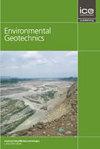有机改性膨润土对苯酚的吸附性能及微观结构变化
IF 2.2
4区 工程技术
Q3 ENGINEERING, GEOLOGICAL
引用次数: 0
摘要
酚类化合物是水生和土壤环境中普遍存在的有机污染物。为了解决含酚废水的处理问题,膨润土可以通过有机改性作为一种有效的吸附剂。本研究的重点是使用十六烷基三甲基溴化铵(CTMAB)改性的钠基膨润土去除水溶液中的苯酚。研究了吸附时间、苯酚初始浓度、CTMAB膨润土用量等因素对苯酚吸附的影响。此外,还分析了有机改性膨润土在吸附过程中的微观结构变化、吸附动力学和吸附等温线。结果表明,OMB的吸附平衡时间比钠基膨润土长。OMB对苯酚的吸附量与苯酚的初始浓度和CTMAB膨润土用量呈正相关。苯酚的最大吸附量和去除率为3.00 mg/g和43.74%。研究还表明,准二阶动力学模型适用于描述OMB对苯酚的吸附过程,吸附等温线符合Freundlich等温线模型。这些发现证明了OMB作为处理含酚废水的高效吸附剂的潜力。本文章由计算机程序翻译,如有差异,请以英文原文为准。
Phenol adsorption properties and microstructural changes of organically modified bentonite
Phenolic compounds are prevalent organic contaminants in aquatic and soil environments. In order to address the issue of phenolic wastewater treatment, bentonite can be utilized as an effective adsorbent through organic modification. The present study focuses on using sodium bentonite, which was modified with cetyltrimethylammonium bromide (CTMAB), to remove phenol from an aqueous solution. The influence of various factors such as adsorption time, initial phenol concentration, and CTMAB-bentonite dosage on phenol adsorption was thoroughly investigated. In addition, the microstructural changes during the adsorption process, adsorption kinetics, and adsorption isotherms of the organically modified bentonite (OMB) were analyzed. The results indicated that the adsorption equilibrium time of OMB was longer compared to sodium bentonite. The amount of phenol adsorbed by OMB was found to be positively correlated with the initial phenol concentration and CTMAB-bentonite dosage. The maximum phenol adsorption capacity and removal rate achieved were 3.00 mg/g and 43.74%, respectively. The study also revealed that a quasi-second-order kinetic model was appropriate for describing the phenol adsorption process of OMB, and the adsorption isotherm was found to conform to the Freundlich isotherm model. These findings demonstrate the potential of OMB as an efficient and effective adsorbent for phenolic wastewater treatment.
求助全文
通过发布文献求助,成功后即可免费获取论文全文。
去求助
来源期刊

Environmental geotechnics
Environmental Science-Water Science and Technology
CiteScore
6.20
自引率
18.20%
发文量
53
期刊介绍:
In 21st century living, engineers and researchers need to deal with growing problems related to climate change, oil and water storage, handling, storage and disposal of toxic and hazardous wastes, remediation of contaminated sites, sustainable development and energy derived from the ground.
Environmental Geotechnics aims to disseminate knowledge and provides a fresh perspective regarding the basic concepts, theory, techniques and field applicability of innovative testing and analysis methodologies and engineering practices in geoenvironmental engineering.
The journal''s Editor in Chief is a Member of the Committee on Publication Ethics.
All relevant papers are carefully considered, vetted by a distinguished team of international experts and rapidly published. Full research papers, short communications and comprehensive review articles are published under the following broad subject categories:
geochemistry and geohydrology,
soil and rock physics, biological processes in soil, soil-atmosphere interaction,
electrical, electromagnetic and thermal characteristics of porous media,
waste management, utilization of wastes, multiphase science, landslide wasting,
soil and water conservation,
sensor development and applications,
the impact of climatic changes on geoenvironmental, geothermal/ground-source energy, carbon sequestration, oil and gas extraction techniques,
uncertainty, reliability and risk, monitoring and forensic geotechnics.
 求助内容:
求助内容: 应助结果提醒方式:
应助结果提醒方式:


